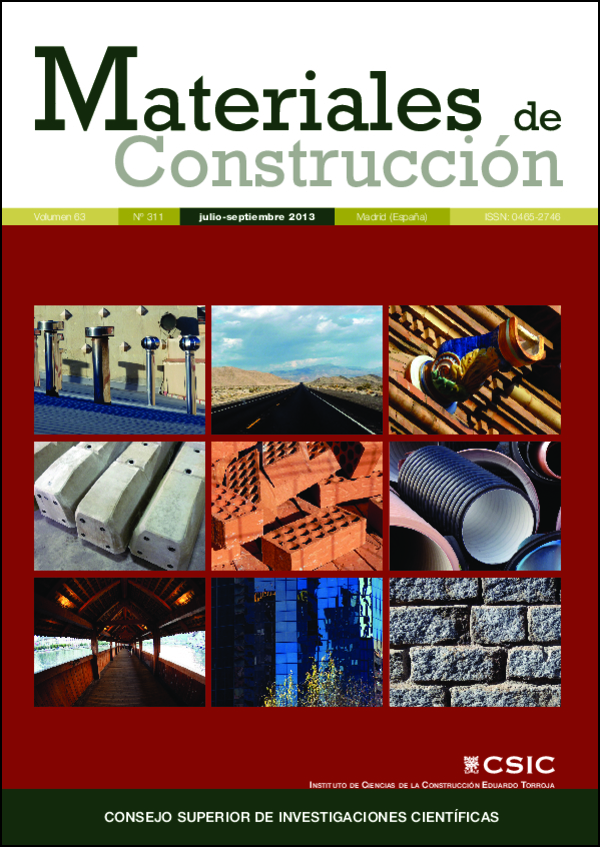Influence of different technological-environmental parameters on the evolution of resistance of concrete, produced in the Province of Valencia
DOI:
https://doi.org/10.3989/mc.2012.01312Keywords:
concrete, temperature, influence, strengthAbstract
In this article on the basis of analysis of the influence of different technological-environmental parameters, such as the type of cement, water/cement ratio, initial curing temperature, time of conservation work, content of cement, additions, additives and consistency in the evolution of the concrete compressive strength, obtained a calculation equations and some graphs to estimate the resistance evolution of the concrete HA-25/B/20/IIa and HA-30/B/20/IIa from 3 to 28 days for each initial temperature curing interval specified and for the sample of concrete. So are based on 67.782 data of different compressive strength of prepared concrete in the province of Valencia during the years 1996 to 2011, that has allowed to compare the equations obtained from regression with a significant database.
Downloads
References
(1) Agrupación de Fabricantes de Cemento de España “OFICEMEN” (2011). http://www.oficemen.com/lstDocumentos.asp?id_cat=148. (Abril 2012).
(2) Ministerio de Fomento. EHE-08. Instrucción Hormigón Estructural. Ministerio de Fomento ed., Madrid, Spain. (2008).
(3) Benlloch Marco, J.: Sistemas de Cimbrado: Acciones Plazos y Problemas Constructivos, Trabajo de investigación para Cátedra de Universidad Politécnica de Valencia, Departamento de Construcciones Arquitectónicas. (1996):
(4) Fernández Gómez, J.; Calavera Ruíz, J.: “Estudio experimental de la evolución de las características mecánicas del hormigón curado en diversas condiciones y su aplicación al cálculo de los procesos de descimbrado”. Hormigón y Acero, nº 169, (1988) pp. 9-20.
(5) Chen, W.F, Mosallam, K.: Concrete buildings: Analysis for safe construction, Boca Raton. Florida, USA. ISBN: 0-8493-85573-70-X (1991).
(6) Ortega Barrionuevo, F.; Fernández Cánovas, M.: “Análisis de las causas que motivan la disminución de resistencias a compresión, por efecto de temperaturas elevadas, en probetas de hormigón conservadas en obras durante el control de recepción”, Cemento-Hormigón, no 934, (2009) pp. 14-25.
(7) Ortiz Lozano, J. A.; Aguado de Cea, A.; Agulló Fité L.; Garcia Vicente T.; Zemeño de León M. E.: “Estudio experimental sobre la influencia de la temperatura ambiental en la resistencia del hormigón preparado. Bases teóricas” Materiales de Construcción, vol. 58, 291, (2008) pp. 7-22.
(8) Gómez, M. S. L.; Vidal Sergio, A.: “Influencia en la resistencia a compresión de hormigones por efecto de la temperatura ambiente” Revista de Construcción vol. 5, nº 1, (2006), pp 56-61.
(9) Ortiz Lozano, J. A.; Aguado de Cea, A.; Agulló Fité L.; Garcia Vicente T.: "Influence of environmental temperatures on the concrete compressive strength: Simulation of hot and cold weather conditions" Cement and Concrete Research, vol. 35, (2005) pp. 1970-1979. http://dx.doi.org/10.1016/j.cemconres.2005.01.004
(10) Ortega Barrionuevo, F.: Influencia de la compactación y conservación de probetas durante su permanencia en obra, así como su posterior refrentado en la resistencia a compresión del hormigón (Periodo 1997-2007). Tesis Doctoral defendida en la Universidad Politécnica de Madrid el año 2010.
(11) Comella, J.; Pico, S.; Taure, E.:“Las Perdidas de Resistencia del Hormigón durante el Verano”, Anales de Construcciones y Materiales Avanzados, vol. 1, (2002) pp. 4958, Ed. UPC, Barcelona.
(12) Elkhadiri I.; Puertas F.: "The efect of curing temperature on sulphate-resistant cement hydration and strength", Construction and Building Materials, vol 22, (2007) pp. 1331-1341. http://dx.doi.org/10.1016/j.conbuildmat.2007.04.014
(13) Mouret A.; Bascoul A.; Escadeillas G.: "Microstructural features of concrete in relation to initial temperature-SEM and ESEM characterization" Cement and Concrete Research, vol 29, (1999) pp. 369-375. http://dx.doi.org/10.1016/S0008-8846(98)00160-4
Downloads
Published
How to Cite
Issue
Section
License
Copyright (c) 2013 Consejo Superior de Investigaciones Científicas (CSIC)

This work is licensed under a Creative Commons Attribution 4.0 International License.
© CSIC. Manuscripts published in both the print and online versions of this journal are the property of the Consejo Superior de Investigaciones Científicas, and quoting this source is a requirement for any partial or full reproduction.
All contents of this electronic edition, except where otherwise noted, are distributed under a Creative Commons Attribution 4.0 International (CC BY 4.0) licence. You may read the basic information and the legal text of the licence. The indication of the CC BY 4.0 licence must be expressly stated in this way when necessary.
Self-archiving in repositories, personal webpages or similar, of any version other than the final version of the work produced by the publisher, is not allowed.
















